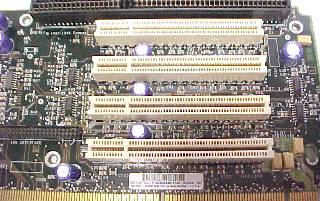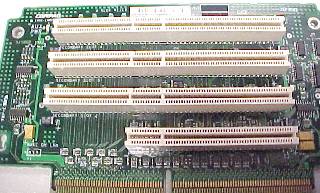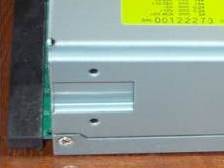Professioneller 19" Rackmount Server Compaq DL380 - DL = "Density Line"
Details zum Compaq DL380 G1 (Nachfolger des 1850R) und unsere Erfahrungen mit den ProLiant Density Line (DL):
Der 3HE hohe Compaq DL 380 G1 (P17 oder Generation 1) Server wurde auf dem Chassis des 1850r aufgesetzt und einige Schwachstellen wurden konsequent elemeniert. Die inzwischen neueren DL380 Typen haben die Erweiterung "G2" (für 2. Generation) oder "G3,4,5....." hinten dran.
Die CPU 1 ist immer links (von vorn gesehen)
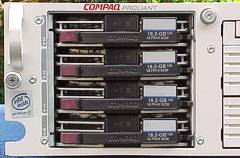
- 4 SCSI Platten als RAID 5
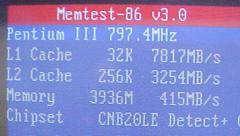
- nicht gigantisch schnell, aber verlässlich
Die Hauptplatine ist nur noch mit einer Schraube fixiert (im Gegensatz zum Vorläufer, dem 1850) und kann dann sofort entnommen werden. Das war beim 1850 eine Krücke. Weit über 10 Schrauben haben die Nerven sichtlich strapaziert.
Bei gleichen VRMs kann man jetzt einen oder zwei Intel PIII ab 633 und schneller bis 1 GHz einbauen. Und jetzt geht der Haupspeicher bis 4 GB PC133 ECC SDRAM in vier Slots, denn der DL380 hat den fast schon edlen Chipsatz von Serverworks (anstelle des Intel BX Chipsatzes) und einen steckbaren Single Chip RAID5 Controller onboard (Option !!).
Der Netzwerk Onboard Chip meldet sich übrigens unter Suse 9.2 Linux als NC3161 Karte ?? aber der Treiber funktioniert.
Auf dem nebenstehenden Bild sehen Sie die abfotografierten Werte des DOS basierten MEM-Test 86. Der Zugriff auf die 4 Gigabyte mit über 400 MB/s ist für Server mit einer oder mehreren schnellen 100 Mbit Karten eine dicke Reserve.
Der DL380 hat dazu endlich drei 64 Bit PCI Slots, der 1850R hatte nur 4 (normale) 32 Bit PCI Slots.
Das 19" Chassis samt Innenleben und die Netzteile sind sonst nahezu baugleich, die Netzteile liefern jetzt 275 Watt, die im 1850r nur 225. Mit etwas Geschick (bzw. leichter intelligenter Gewalt) kann man die Sperre entfernen und die kleineren Einschübe vom 1850r gehen auch. Sie sollten alle Ihre Verbraucher (CPUs, Platten, Memory usw.) aber schon mal aufsummieren
Treiber gibts hier:
h18023.www1.hp.com/support/files/server/us/locate/20_1122.html
Da gibt es auch ein 78 MB großes Supportpack für WIN2000, in dem alle Treiber drinnen sein sollen.
h18023.www1.hp.com/support/files/server/us/download/21282.html
Übrigens, selbst Cisco hatte die Compaq DL380 unter eigenem Label vermarktet als Cisco MCS 7835 VOIP Server CM 3.0. Wenn das nichts Gutes sein soll.
Wir betreiben diese Server mit WIN NT 4.0 SP6 (nicht 6a !!) sowie Netware 4.11 SP9. Das mit Netware 4.11 war schon ein Kampf, bis es lief, man muß nur die Tricks kennen.
Rechts sehen Sie die "Riser Card" des 1850r mit 4 x 32 Bit PCI und 1 x 16 Bit ISA. Damit war die gesamte PCI-Bus-Geschwindigkeit natürlich begrenzt, zumal der 440BX nur einen PCI Kanal hat.
Hier sehen sie die verbesserte 64 Bit PCI Riser Card aus dem DL 380, die jetzt fast "Power ohne Ende" liefert. Die drei oberen 64Bit PCI Slots werden von dem zweiten PCI Kanal völlig separat angesteuert. Der untere 32 Bit Slot teilt sich die PCI Bandbeite mit onboard VGA, onboard SCSI, onboard Netzwerk Chip und onboard super I/O Chip.
Wir werden das mit Gigabit Ethernet- und Fibre Channel- Karten ausführlich testen und ! dokumentieren.
Und beim gleich großen (wie beim 1850R) aber verstärkten 275 Watt Powersupply müssen Sie auf diese Nase achten, sonst geht es nicht rein.
Mit einem Trick können Sie auch die 225 Watt Einschübe des 1850R verwenden - jedenfalls wenn Sie wegen der "nur" 225 Watt auf die maximale Ausbaustufe verzichten.
Hier die Detail Beschreibung des DL380 in englischer Sprache, wie wir sie per E-Mail erhalten haben :
Processor
The Proliant DL380 shipped with a single Pentium III processor in a FCPGA package. The processor supports a 133 MHz front side bus. All models are dual processor capable.
Network Controller
The Proliant DL380 features an embedded 10/100 Mbit Ethernet controller that automatically detects 10 and 100 Mbits/s network connections.
SCSI and RAID
The Proliant DL380 has two embedded 80 MB/s Wide Ultra2 SCSI channels. The drive bays support disk hot-plugging. The standard ROC RAID module turns the embedded SCSI controller into a SMART RAID Array controller.
IDE Controller and Video
The integrated CD-ROM drive is a 32x IDE drive. The Proliant DL380 does not support IDE disks.
The Proliant DL380 has an embedded ATI Rage IIc video controller, 4 MB of video memory and provides a resolution of 1600 x 1200.
Form Factor
The Proliant DL380 is available only in a 3U rack chassis. It ships with ball bearing sliding rails and a cable management arm.
System Architecture
The Proliant DL380 is designed around the ServerWorks (RCC) 3.0 chipset and supports two processors and up to 4 GB of memory.
The FSB (front side bus) speed is 133 MHz and allows a 33% higher transfer rate than provided by 100 MHz based systems. The peak burst transfer rate is 1.06 GB/s.
The chipset is divided into two separate ASICs. The CNB30LE ASIC serves as the host interface, memory controller and PCI expansion bus controller. It allows synchronized 133 MHz data transfers between SDRAM and Intel Pentium III processors. Integrated into the CNB30LE ASIC are separate 32-bit and 64-bit PCI bus interfaces. The two PCI buses operate on the same 33 MHz clock but function independently in a dual peer bus architecture. This increases system performance by allowing concurrent traffic on the two buses. Maximum data transfers on the 64- and 32-bit PCI buses are 267 MB/s and 133 MB/s respectively.
The OSB4 ASIC resides on the primary PCI bus. Integrated into the chip is the PCI-to-ISA bridge and the IDE controller. There are no ISA slots in the system. The only devices on the ISA bus are the embedded National 97317 SuperIO controller and the system ROM.
Processors
The Proliant DL380 supports two Intel Pentium III processors with a 133 MHz FSB in a slot-1 cartridge. These Intel Pentium III processors have three innovations: The 0.18 micron technology allows the chip to run cooler and take up less space on the wafer. The Advanced Transfer Cache (L2 cache) has been integrated into the processor die and is accessed at full processor speed. The size of the L2 cache is 256K. The speed of the front side bus (FSB) has been increased to 133MHz. A Pentium III processor cannot be underclocked or overclocked.
Service Considerations
For the system to function properly, processor slot 1 must be populated all the time. The processor switch settings do not require any adjustment. The system automatically configures the processor speed. Both processors must have the same speed. The second processor slot is terminated automatically, if it is not populated. A terminator card is not required.
Processor Power Modules
One processor power module (PPM or VRM - voltage regulator module) is required for each processor. The PPM does not support redundant operation. The module automatically provides the required processor voltage (Voltage-ID technology). The second PPM is part of the processor upgrade kit.
Memory
The host bus interface between processors and memory runs at 133 MHz and has a peak transfer rate of 1.06 GB/s.
There are four DIMM sockets on the system board. A memory upgrade requires PC133 registered ECC SDRAMs. EDO and 100 MHz SDRAM is not supported.
DIMMs are installed one at a time. 4 GB of RAM can be attained by installing four
1 GB DIMMs. Standard memory in all Proliant DL380 systems is a single 128 MB DIMM.
Any combination of 64, 128, 256, 512 MB and 1 GB DIMMs may be used. Install memory modules one at a time starting with slot 1.
Technical Data
Max RAM: 4 GB
RAM type: Registered SDRAM
Protection: ECC
Speed: 133 MHz (PC133)
Contacts: gold
Sizes: 64 MB, 128 MB, 256 MB, 512 MB, 1 GB
Redundant System ROMs
The Proliant DL380 has redundant system ROMs. The system will automatically use the redundant ROM image if the primary ROM is corrupt (POST error 105). If both images are corrupt, insert a RomPaq diskette and enable disaster recovery mode by setting SW2 switches 1, 4, 5 and 6 to the ON position and then initiate a power cycle. Both ROMs always have identical firmware images.
PCI Slots
The Proliant DL380 has a total of four PCI slots on the riser card. All slots run at 33 MHz and are 5 Volt keyed. The slots are balanced across two PCI buses. The DL380 has no ISA slots.
Primary Bus - The primary bus has one 32-bit PCI slot. The data transfer rate on this bus is 133 MB/s. There is one 32-bit PCI slot on the primary bus. The following components are embedded on the primary bus: ATI Rage IIc video controller, Dual Channel Wide Wide Ultra2 controller, SMART module, Intel 82559 NIC and PCI-to-ISA bridge.
Secondary Bus - The secondary bus is dedicated to the three 64-bit PCI slots. The secondary bus has twice the bandwidth of 32-bit PCI and full support for 64-bit expansion cards. This allows users to optimize the system for 267 MB/s data transfers on the bus.
Riser Board
The riser board is attached to the chassis by two screws. When removing the riser board, do not separate the riser board from the riser brace. These two components are a single assembly unit.
Embedded SCSI Controller
All Proliant DL380 models have two Wide Ultra2 SCSI channels based on a LSI- Logic 53C1510 chip. This dual-channel Wide Ultra2 SCSI controller is embedded on the primary PCI bus and delivers data at 80 MB/s per channel. Both channels are backward compatible with Fast, Fast Wide and Wide Ultra SCSI devices. The controller also supports Ultra3 disk drives. These, however, will run in Wide Ultra2 mode.
The Proliant DL380 has one external and two internal 68-pin connectors. Do not connect devices to the external and internal port A (port 1) at the same time. If the external port is used, the cable from the internal port A (port 1) must be removed. All unused connectors are automatically terminated.
The Proliant DL380 ships with a preinstalled twisted pair point-to-point SCSI cable that connects the hot-plug drive cage to port-2 on the system board. The second SCSI cable is a two-device terminated cable which is used to connect SCSI devices in the option bays to port-1 on the system board.
RAID Module
The ROC (Raid on a Chip) RAID module ships standard with the Proliant DL380 and provides Smart Array controller technology. The RAID module provides RAID support for the internal disk drives and retains support for external tape backup systems. Features include:
8 MB read cache
Support for RAID 0, 1, 1+0, 5
Online spare with automatic data recovery
Online RAID level and stripe size migration
Online capacity expansion
Data compatibility with higher performance Smart Array controllers
The RAID module does not support RAID technology for disk drives that are connected to the external SCSI connector. The external SCSI connector should only be used to connect a tape device.
The RAID module is data compatible with the whole family of SMART controllers.
Embedded 10/100 Ethernet Controller
The Proliant DL380 has an embedded Intel 82559 network controller. It is identified as a NC3163 network controller. The 82559 automatically detects the network speed and switches automatically between 10 Mbps and 100 Mbps. Full-duplex operation is also supported. The 82559 controller has Wake On LAN capability. WOL is used to "wake up" the server from a low power state through a network connection. Status of the embedded NIC is available by looking at the link LED and status LED on the rear of the server and on the front panel.
Common Driver Support
All Intel-based 10 or 100Mbps network controllers use common operating system drivers. No driver change is required when moving from 10 to 100 Mbps. Common drivers provide consistency and easy management.
Fault Tolerance
Pairing the embedded NIC with another HP Intel-based NIC ensures that the server can always keep an active link. If the primary network connection fails, the second, backup NIC will automatically take over—retaining the network connection.
Chassis / Power Switch
The chassis of the ProLiant DL380 is the same as the Proliant 1850R chassis. The power switch toggles between On and Standby. Press the power switch for more than 4 seconds to switch it off instead of switching it into standby mode. Before servicing any non hot-plug parts always disconnect the power cord.
Drive Cage
The system ships with a drive cage that supports four Wide Wide Ultra2 or Ultra3 disk drives. WU2 and U3 drives can be mixed. Only 1" drives are supported. The drive cage is identical with the one used in the Proliant 1850R. With the optional dual-drive cage the number of internal disks can be increased to six.
SCSI-IDs are set automatically and depend exclusively on the drive bay selected. Termination is handled automatically by the backplane board of the drive cage.
Option Bays
The Proliant DL380 has two available option bays. The upper two bays ship standard with a 1.44 MB floppy disk drive and a 32x IDE CD-ROM drive. The lower two option bays are available for any SCSI device or a second IDE CD-ROM drive. The embedded IDE controller only supports CD-ROM drives. IDE disk drives are not supported.
Power Supply
The Proliant DL380 ships with a single 275 Watt hot-plug power supply. In order to make the power supply redundant a second power supply must be installed. To remove the power supply push in the portwine-colored tabs and pull the tab out until it opens. Always make sure that an empty power supply bay is covered with a blanking panel. The 225 Watt power supply of the Proliant 1850R is not supported in the Proliant DL380. During POST a power supply must be present in bay 1 (right bay).
Fans
Three fans ship standard with the Proliant DL380. The system fan is mounted just behind the hot-plug drive bay area. The processor fan (rear fan) is located behind the processor slots. A third fan is installed in the power supply unit. Redundant fans are not supported.


